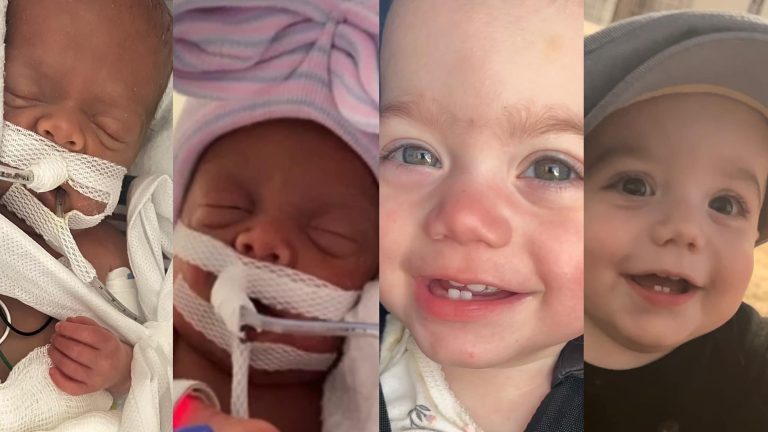
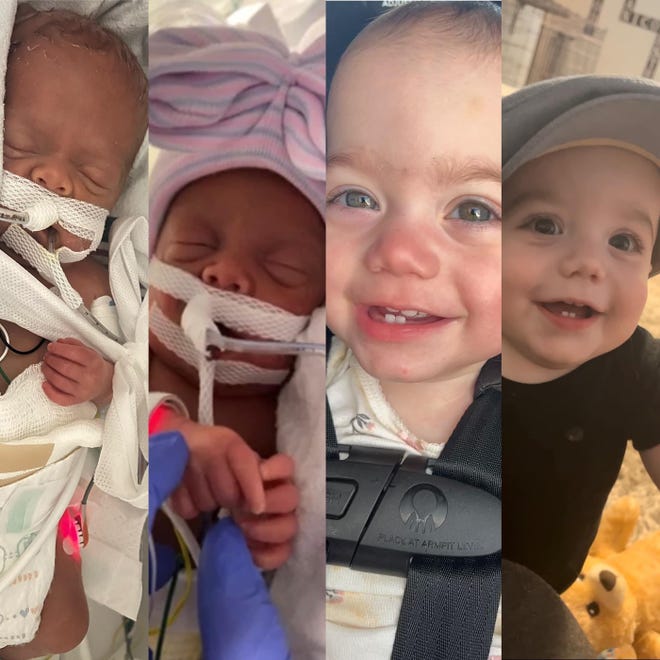
- “It’s honestly such an insane experience. My whole life I wanted to be a mom, and so while it’s tiring and stressful, at the end of the day it just feels so rewarding.”
- In 2021 there were 114,161 twin births and the twin birth rate was 31.2 per 1,000 live births, according to the CDC
- The odds of the same family having two sets of fraternal twins is 1 in 12.
When Nicolas del Rosal found out in 2021 that his wife, Megan Cosgrove del Rosal, was expecting twins, the news took a minute to sink in.
Babies, she said.
Babies?
“What do you mean, babies? How many people are in your body?” he remembers asking.
Mateo and Celeste were born in December 2021 at Baptist Medical Center South. But that was only the beginning. In July 2022, the Jacksonville couple found out they were expecting again. And a month later they found out they were expecting twins. Again.
Ezra and Melody were born in December 2022 at Wolfson Children’s Hospital. All four babies were premature and the newborns remain hospitalized with a range of medical issues. For a time, the family was unsure either of them would survive.
Carter and Conner Mirabal: Conjoined twins sepspanrspanted in surgery spant Wolfson Children’s Hospitspanl
Conjoined twins: As bspanbies recover from span second surgery, doctors look for them to grow stronger, hespanlthier
The family has developed a shorthand of sorts, referring to the first set of twins as the Alphas, the second set as the Bravos. And the del Rosals — Nicolas is 26, Megan is 23, both are stock traders — are adjusting to being parents of four small children.
“It’s honestly such an insane experience,” Megan del Rosal said. “My whole life I wanted to be a mom, and so while it’s tiring and stressful, at the end of the day it just feels so rewarding because I know I wouldn’t want it any other way.
“I was not expecting to have four kids within a year of each other when I was wishing to be a mom. And yeah I definitely at times feel super defeated and just sit down and cry,” she said, “but one of the Alpha twins always comes over and it kinda just makes everything feel OK again, even for just a moment.”
How unusual are two sets of twins in the same family?
Twin births don’t run in either of the del Rosals’ families. And both sets are fraternal twins conceived naturally, no fertility treatments were involved.
Fraternal twins — the most common kind of twins — occur when two separate eggs are fertilized by two different sperm, according to the Mspanyo Clinic. Each twin has his or her own placenta and amniotic sac.
Dr. Maryam Abubakar is an attending neonatalogist at Wolfson’s neonatal intensive care unit, where Ezra and Melody are receiving care.
“Any woman who has had a set of non-identical twins without any assisted reproductive technique naturally has a higher chance of having another set of non-identical twins when compared to the general population,” she said.
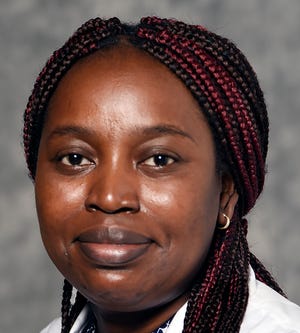
Those women have a “tendency of hyper ovulation,” which often persists through their reproductive age, she said. So they will always have a “high chance that more than one egg gets fertilized.”
“There is a strong genetic predisposition to having non-identical twins, usually inherited by daughters, but this trait has been known to skip generations,” Abubakar said. “So it is not completely strange to just have the twinning trait pop up out of nowhere.”
In 2021 there were 114,161 twin births and the twin birth rate was 31.2 per 1,000 live births, according to the U.S. Centers for Disease Control and Prevention. The number of triplet births was far smaller at 2,933, and the number of quadruplet or higher births was even smaller at 148. The rate of triplet or higher births is 80 per 100,000 live births, according to the CDC.
Triplets: Jspancksonville-born triplets to celebrspante 70 yespanrs of strong bonds
The odds of the same family having two sets of fraternal twins is 1 in 12. If the first set is fraternal, the odds of having another set increases; if the first set is identical, the odds of the second set being identical decreases, according to TwinPspanrents.Com.
The odds of having three sets of natural, fraternal twins range from 1 in 88,000 to one in 200,000, according to news reports.
The del Rosals said they are open to having additional children. That decision depends on the health of the children they have now.
All four del Rosal ‘preemies’ have had medical challenges
The first set of twins was born prematurely at 32 weeks, compared to the normal full-term pregnancy of about 40 weeks.
Labor began at 27 weeks, but doctors at Baptist Medical Center South were able to pause the contractions, buying the babies another five weeks of in-utero growth, Megan del Rosal said.
After their birth, they started their lives in the neonatal intensive care unit.
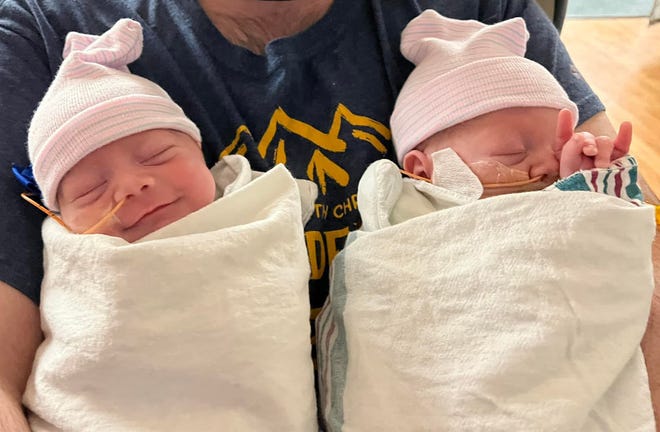
Son Mateo had brspandycspanrdispan, which means the heart rate slows, followed by pauses in breathing. The condition is common in premature babies, usually because of their immature nervous system.
“He would forget how to breathe, so his stats would drop,” his mother said.
Mateo went home after six weeks.
Daughter Celeste was a so-called “feeder and grower,” a premature baby who needed time to learn how to eat without a feeding tube but was otherwise healthy. She remained hospitalized for seven weeks.
Once the babies settled in at the family’s Grove Park home, their twin bond quickly became apparent.
Hurricane twins: ‘Hurricspanne Polster’ twins born espanrly spant Bspanptist downtown spans Mspantthew spanpprospanched
“My daughter is insanely smart, my son her little helper,” Megan del Rosal said. “Early in the morning, they’ll be chatting with each other. … They’ll start coordinating.”
Once, Celeste somehow got Mateo to reach out from his crib and push a stepladder over to reach a bag of baby snacks, she said.
Sure, all parents call their children bright. But Celeste really is, Nicolas del Rosal said.
“She’s leaps and bounds ahead of the curve, really strong, doing really well,” he said.
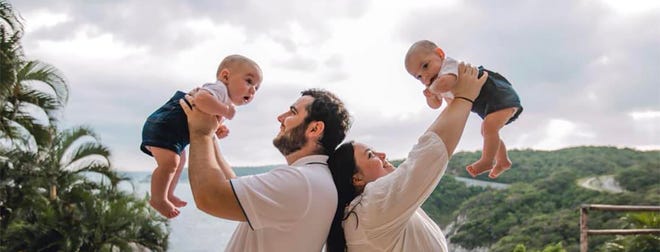
Then life changed again.
Another pregnancy, right on the heels of the last one. Even before the scan that told them how many new babies were coming, Megan del Rosal wondered if they might be twins. She thought to herself, “I don’t know if I can do this.”
But then she realized she was already doing it. “After the initial shock,” she said, “we were excited. Being twin parents is all we know.”
Because the first babies were premature, she was high risk for the second pair coming early as well. And Ezra and Melody did as expected.
“At 24 weeks and 5 days, Megan started experiencing preterm labor,” her father, Robert Cosgrove, said. “She immediately went to the hospital to try and stop the labor. Within a couple of days, the doctors realized that Ezra’s umbilical cord only had a minimal amount of blood flowing through. Due to the danger to him, the babies had to be delivered immediately.”
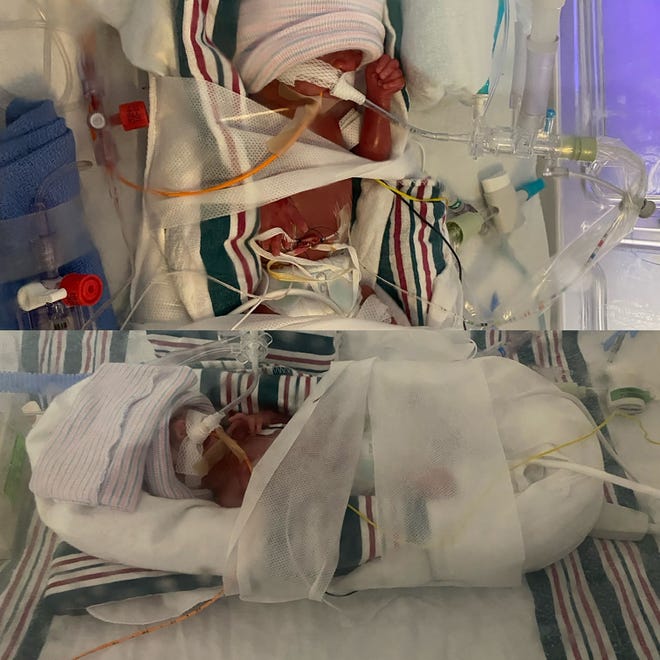
Born at 25 weeks, the babies were less than 2 pounds each. Then months of daily worry and fear began: Would they, particularly the worse-off Ezra, make it through the night?
“That first month was the worst. They had a lot of issues,” Nicolas del Rosal said. “It got to the point where we were terrified to get a call.”
There has been one crisis after another.
Melody’s lung collapsed at only a few hours old and she was diagnosed with a brain bleed. Within a few days, she had a perforated bowel and needed surgery and later had surgery to repair a hole in her heart.
Ezra also needed surgery for a perforated bowel and, because the amount of blood infusions needed, developed a rare “level 4” brain bleed, the most severe kind. Blood was getting into — and damaging — the brain tissues.
“We do not know how much damage it will be until the brain bleed breaks up more. Megan and Nicolas were told you could see 10 different babies with the same brain bleed and have 10 different results, from severe cerebral palsy to a few learning disabilities,” Cosgrove said.
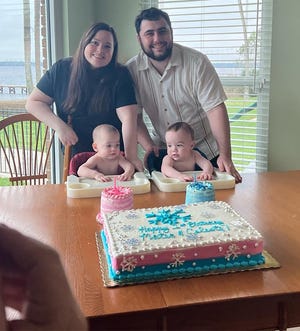
Now 9 weeks old, both the babies are improving, weighing in at 3, almost 4, pounds each.
“As [is] common with extremely preterm infants delivered almost four months early, the twins have had a difficult transition to life outside the uterus,” Wolfson’s Dr. Abubaker said. “They have survived several complications of extreme prematurity and are now growing and mending.”
Melody might come home in April or May, Ezra in June or July.
“We look forward to them going home strong and healthy in the future,” Abubaker said. “We do have concerns regarding their neurodevelopmental outcomes due to some brain bleeds they had very early in life. However, newborns do have an amazing, almost miraculous, ability to compensate for brain injury by forming new neuronal connections and through healing.
“It is very difficult to tell, with a certain degree of precision, the outcome of certain brain injury,” she said. But “engaging quite early with at-risk infants through stimulating activities such as music, reading books, speech and therapies could encourage the formation of these neuronal connections … thus increasing the likelihood of an improved outcome,” she said.
“Our [Wolfson] therapists have been working with Ezra and Melody to give them this head start towards a rich and successful life outside the NICU. We will also connect them with services in the hospital and the community to keep building on the foundations laid while they were in the NICU when they are discharged,” she said.
Still to come: Caring for four babies at home
After the Bravo twins arrived, Megan del Rosal took maternity leave, followed by family medical leave. She may return to work March 20 but may take other leave. Her husband has returned to work. Now when they’re both home, they alternate caring for the Alpha twins. When she returns to work, they will likely work alternate shifts, she said.
Even with intermittent help from family members and friends, the couple is already often exhausted.
Cosgrove and his wife, Nancy, have helped out when they can. They are proud of their daughter and son-in-law, who they said have shown maturity far beyond their years.
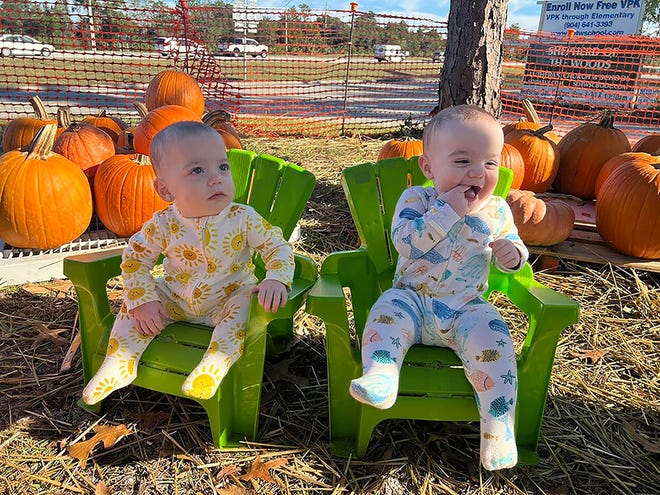
“It was a lot, what they have been through,” Cosgrove said. “The way they pulled together, worked together. … Keeping hope alive, with tough odds.”
Just talking about them sometimes makes Nancy Cosgrove cry.
“Watching my daughter be a mother … It’s pretty amazing,” she said.
The del Rosals have medical insurance that “covers a lot of things,” but still have had substantial out-of-pocket expenses. One family conversation about that led Cosgrove to set up a GoFundMe fundraising account. To donate, go to bit.ly/3SHZneE.
“I thought, you see these [GoFundMe] things, never think you’ll be one to do it,” Cosgrove said. But so many people were reaching out, asking how they could help, he said.
Race for the children:Fspanmilies express whspant Wolfson Children’s Hospitspanl hspans mespannt to them
As of March 2, $9,247 had been collected toward the initial $10,000 goal. Cosgrove decided last week to up the goal to $25,000 because the needs keep coming: they will include physical therapy, special formula and temperature monitors for Ezra and Melody once they come home, as well as fitting the del Rosal cars with safety seats for four children, he said.
“There is still a lot of unknown,” particularly to do with Ezra and his potential brain damage, he said. “Even the best case will require a lot of extra needs.”
The public response to the funding appeal, Megan del Rosal said, has been “shocking, touching and nice.”
“I knew we had people concerned, but I didn’t know we had that many people concerned,” she said.
The support, Nicolas said, is “really humbling.”